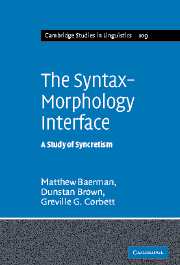Book contents
- Frontmatter
- Contents
- Preface
- List of abbreviations and symbols
- 1 Introduction
- 2 Characteristics of syncretism
- 3 Cross-linguistic typology of features
- 4 Formal representation
- 5 Formal framework and case studies
- 6 Conclusion
- Appendix 1 Case syncretism in the World Atlas of Language Structures sample
- Appendix 2 Person syncretism in the World Atlas of Language Structures sample
- Appendix 3 Syncretism in two-place verbs in the World Atlas of Language Structures corpus
- Appendix 4 DATR fragment for Dhasaanac case study
- Appendix 5 DATR fragment for Dalabon case study
- Appendix 6 DATR fragment for Russian case study
- References
- Author index
- Language index
- Subject index
2 - Characteristics of syncretism
Published online by Cambridge University Press: 22 September 2009
- Frontmatter
- Contents
- Preface
- List of abbreviations and symbols
- 1 Introduction
- 2 Characteristics of syncretism
- 3 Cross-linguistic typology of features
- 4 Formal representation
- 5 Formal framework and case studies
- 6 Conclusion
- Appendix 1 Case syncretism in the World Atlas of Language Structures sample
- Appendix 2 Person syncretism in the World Atlas of Language Structures sample
- Appendix 3 Syncretism in two-place verbs in the World Atlas of Language Structures corpus
- Appendix 4 DATR fragment for Dhasaanac case study
- Appendix 5 DATR fragment for Dalabon case study
- Appendix 6 DATR fragment for Russian case study
- References
- Author index
- Language index
- Subject index
Summary
We shall map out the range of data to be considered. We include problems familiar from the widely cited languages, but we shall also considerably extend the scope of the discussion and of the languages investigated. We first look at the patterns of syncretism and their implications (Chapter 2: §2.1), and then examine the domains which allow us to compare paradigms (Chapter 2: §2.2). This permits us to begin considering the types of analysis available (to be discussed fully in Chapter 4). In Chapter 2: §2.3 the important issue of directionality is raised. Then we consider the ‘extreme’ interpretations in Chapter 2: §2.4, namely neutralization and uninflectedness. These prove to describe the easy instances: the more challenging ones lie in between and form the subject of the remaining chapters.
Syncretic paradigms
Types
As we have characterized it, syncretism involves the identity of cells within an assumed morphosyntactic paradigm. Graphically, we shall represent this by generating a complete inflectional paradigm, and enclosing the identical forms within a box. Before considering what morphosyntactic values may form the parameters, let us outline a brief typology of the ways paradigmatic cells may be united. These are illustrated below with examples of case syncretism. The different types will turn out to have important consequences for the representation of feature structure.
In the simplest pattern, which we call simple syncretism, two or more cells with different values for a feature are merged.
- Type
- Chapter
- Information
- The Syntax-Morphology InterfaceA Study of Syncretism, pp. 13 - 36Publisher: Cambridge University PressPrint publication year: 2005



